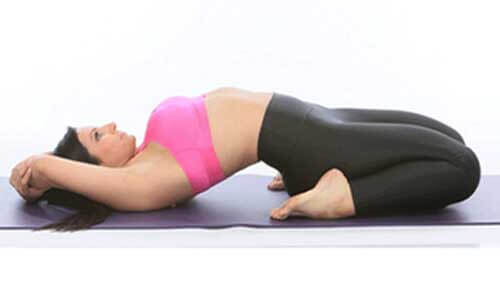
Supta Vajrasana
Supta Vajrasana, translated as Supinal thunderbolt pose, is modified Vajrasana that is widely practiced for toning the abdominal muscles and helping you gain flat belly. Those who practice it regularly recommend this pose for improved digestion and better energy level.
Like Vajrasana, you can practice this pose after heavy meals – 3 to 5 times if you are a beginner, increase up to 8-10 times in the due course. After sitting in Vajrasana with your buttocks on the heels, straightened back and neck. Remove the palms from your thighs and place them behind your both heels on the floor. One at a time, put your forearms on the ground and bend back with support of your elbow. Bend your head back to touch the ground with back arched. Put the hands on thighs and hold this position – breath deep and slow.
It is a simple asana that can be practiced after lunch or dinner. It is also known as diamond pose and is used for meditation and practising breathing exercise. Regular practice of this asana makes you stronger and healthier. People with joint pain, knee and/or back injury should not try this pose. Also, avoid the pose if you suffer from high blood pressure, slipped disc, and vertigo. Women should avoid this pose during menstrual cycle and pregnancy.
Supta Vajrasana steps
1. Begin with Vajrasana.
2. Place both palms on the floor beside the bottom, fingers should point to the front.
3. Bending back slowly, place your forearms and elbows on the ground.
4. Touch the floor with your head and arch the back so as to have an open space between your back and the floor creating a bow like structure with your hips seated on the heels and head touching the ground.
5. Place your hands on the thighs.
6. Try to maintain the contact of your lower legs with the floor, you may have to separate the knees.
7. In this position, close your eyes and relax the body. Take deep and slow breaths 4-5 times.
8. To release this pose, keep your forearms and elbows in the ground with palms downward and fingers pointing the front.
9. Take your head off the ground with support of your elbow and forearms.
10. Slide your body left and shift the body weight to forearms and elbows.
11. Sit in Vajrasana.
12. Repeat Supta Vajrasana 3 to 5 times gradually increasing it up to 8 to 10 times per practice.
Awareness
Don’t practice Supta Vajrasana if you have joint pain, knee or back injury. People suffering from high blood pressure, slipped disc, vertigo should not do this asana. If you are pregnant or going through menstruation, avoid this asana. While releasing the pose, don’t straighten the legs at first; this may dislocate the knee joints.
Health Benefits of Supta Vajrasana
1. Supta Vajrasana is massage to the abdominal organs. This alleviates digestive ailments and constipation.
2. Spinal nerves get toned, back becomes flexible and the rounded shoulders get realigned.
3. Stimulates the nerves in the neck, thyroid and parathyroid glands.
4. Regular Supta Vajrasana practice results to stretched and expanded rib-cage and releases pressure on the disc – better respiratory function – treatment to asthma, asthma, bronchitis and other lung ailments.
5. Expansion of disc releases the nerves emanating from spinal cord – this relives back pain caused by squeezing of the spinal nerves and helps discs to resume their correct position.
6. This pose loosens and strengthens legs – you will gain better sitting postures for meditation.
7. Better blood circulation to the brain - enhances courage, confidence, creativity and intelligence.
8. Regulates the functioning of adrenal glands, helps control anger, aggression and relaxes mind.
9. Tones pelvic muscles and alleviates male/female reproductive organs disorders.
Variation of Supta Vajrasana
A common variation can be not resting the head on the ground, instead fold and keep your both hands and rest your head on the folded hands. Your back should rest (not arch) on the ground. By doing this, you will stretch the lower abdominal region. Breathing will be normal, inhaling through nose and exhaling through mouth.